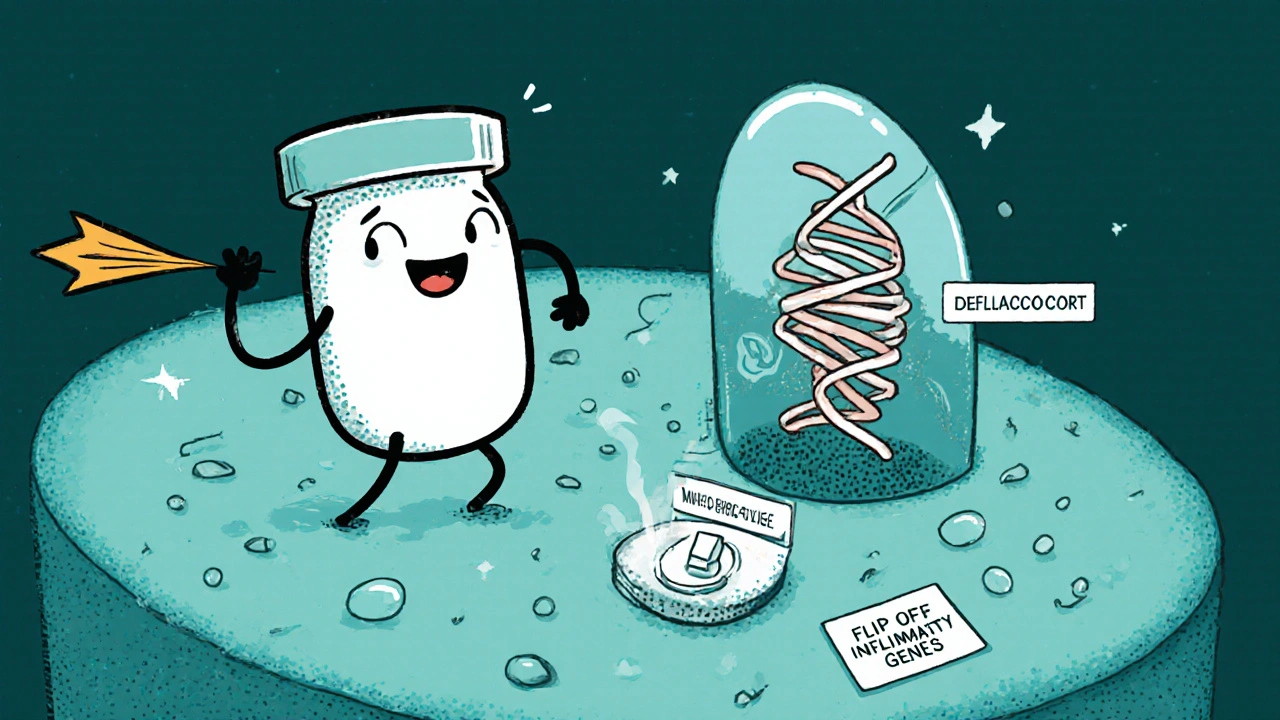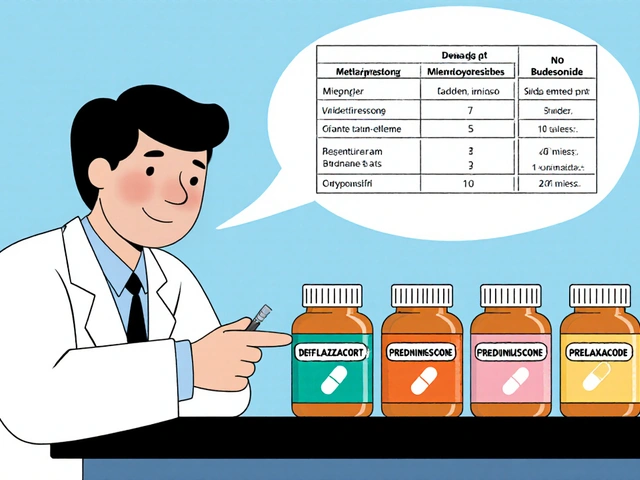Steroid Dose Conversion Calculator
Steroid Dose Converter
Convert between different glucocorticoid steroids using relative potency ratios. Note: Always consult your healthcare provider before changing medication doses.
Calcort (Deflazacort) is a synthetic glucocorticoid medication used to reduce inflammation and modulate the immune response. If you’ve been prescribed this drug or are looking at it alongside other steroids, you probably wonder how it measures up in potency, side‑effect profile, and cost. Below you’ll find a head‑to‑head look at the most common alternatives - prednisone, prednisolone, methylprednisolone, hydrocortisone, and budesonide - plus a quick decision framework to help you pick the right one for your condition.
Key Takeaways
- Deflazacort offers similar anti‑inflammatory power to prednisone but usually causes less weight gain and bone loss.
- Prednisone remains the workhorse for acute flare‑ups because it acts fast and is inexpensive.
- Methylprednisolone delivers higher potency in a smaller dose, making it a favorite for IV therapy.
- Hydrocortisone is the closest to the body’s natural cortisol and is best for adrenal insufficiency.
- Budesonide provides strong local action in the lungs or gut with minimal systemic exposure.
How Deflazacort Works
Deflazacort belongs to the Glucocorticoid class. It binds to intracellular glucocorticoid receptors, travels to the nucleus, and switches off genes that produce inflammatory proteins. The result is a broad suppression of immune activity, which helps in conditions like Duchenne muscular dystrophy, rheumatoid arthritis, and severe asthma.
Typical Clinical Uses of Calcort
Doctors prescribe Calcort for:
- Muscular dystrophy - slows loss of muscle strength.
- Rheumatoid arthritis - reduces joint swelling.
- Severe asthma - controls chronic inflammation when inhaled steroids aren’t enough.
- Autoimmune skin disorders - such as lupus erythematosus.
Benefits Compared to Other Steroids
Clinical trials show that Deflazacort tends to cause less weight gain and a smaller drop in bone mineral density than prednisone at equivalent anti‑inflammatory doses. Patients also report a lower incidence of cataracts over long‑term therapy. These differences stem from Deflazacort’s slightly different molecular shape, which alters how it interacts with mineralocorticoid receptors.

Side‑Effect Profile
All steroids share a core set of risks: hyperglycemia, mood swings, increased infection susceptibility, and adrenal suppression. Deflazacort’s unique profile includes:
- Reduced sodium retention - helpful for patients with hypertension.
- Potential for mild gastritis - usually managed with a proton‑pump inhibitor.
- Less pronounced facial rounding ("moon face") compared with prednisone.
Serious adverse events are rare but can include osteonecrosis of the femoral head and severe psychiatric reactions. Regular monitoring of blood glucose, bone density, and eye health is advised.
Alternatives at a Glance
Below is a snapshot of the most frequently used alternatives. Each has its own sweet spot in terms of potency, onset, and side‑effect pattern.
| Steroid | Typical Dose Range | Relative Potency* | Onset of Action | Common Indications | Notable Side Effects |
|---|---|---|---|---|---|
| Deflazacort | 6‑30 mg/day | ≈0.7 × Prednisone | 2‑4 h | Duchenne MD, RA, severe asthma | Less weight gain, mild gastritis |
| Prednisone | 5‑60 mg/day | Reference (1×) | 1‑2 h | RA, COPD exacerbations, skin disorders | Weight gain, osteoporosis, mood swings |
| Methylprednisolone | 4‑48 mg/day (or IV bolus) | ≈1.25 × Prednisone | 30‑60 min (IV) | Acute flares, neurology, ophthalmic inflammation | Higher potency → stronger HPA suppression |
| Hydrocortisone | 15‑30 mg/day | ≈0.25 × Prednisone | 30‑45 min | Adrenal insufficiency, mild inflammation | Mineralocorticoid effects - fluid retention |
| Budesonide | 200‑800 µg inhaled or 3‑9 mg oral | ≈0.5 × Prednisone (systemic) | 1‑2 h (systemic) | Asthma, Crohn’s disease, ulcerative colitis | Low systemic side‑effects, local irritation |
*Potency is relative to prednisone based on anti‑inflammatory effect.
When to Choose Deflazacort Over Others
Consider Deflazacort if you need long‑term therapy and are worried about weight gain or bone loss. It’s especially useful in pediatric neuromuscular disorders where preserving growth is critical. For rapid, high‑dose bursts (e.g., severe MS relapse), methylprednisolone’s fast IV action is preferable.
Decision‑Making Checklist
- Condition severity: Acute flare vs chronic management.
- Desired potency: Low (hydrocortisone) to high (methylprednisolone).
- Route of administration: Oral, IV, inhaled, topical.
- Side‑effect tolerance: Weight, bone health, blood sugar.
- Cost and availability: Generic prednisone is cheap; Deflazacort may be pricier in some markets.
Practical Tips for Safe Steroid Use
- Never stop a steroid abruptly - taper over weeks to avoid adrenal crisis.
- Pair with calcium and vitamin D supplements if you’re on long‑term therapy.
- Schedule regular labs: fasting glucose, HbA1c, bone density every 1‑2 years.
- Monitor blood pressure, especially with steroids that have mineralocorticoid activity (e.g., hydrocortisone).
- Discuss vaccination timing - live vaccines should be avoided while on high doses.
Frequently Asked Questions
Is Deflazacort stronger than prednisone?
Deflazacort is slightly less potent on a milligram‑for‑milligram basis (about 0.7×). Doctors usually prescribe a higher milligram dose to achieve the same anti‑inflammatory effect as prednisone.
Can I switch from prednisone to Deflazacort without a taper?
A direct switch is possible if the total glucocorticoid load is equivalent, but a short taper is recommended to let the adrenal glands adjust.
Which steroid has the lowest risk of bone loss?
Deflazacort consistently shows the smallest decline in bone mineral density compared with prednisone and methylprednisolone in long‑term studies.
Is Budesonide a good alternative for asthma?
For many asthma patients, inhaled budesonide is preferred because it delivers high local doses to the lungs while keeping systemic exposure low, reducing the chance of weight gain or bone loss.
How often should I get blood tests while on a steroid?
Check fasting glucose and electrolytes within the first month, then every 3‑6 months if you stay on a medium‑to‑high dose. Bone density scans are usually done annually.
Choosing the right steroid isn’t a one‑size‑fits‑all decision. By weighing potency, side‑effect risk, cost, and how quickly you need relief, you can land on the option that balances effectiveness with safety. Talk to your prescriber about these factors, and don’t hesitate to ask for a trial period or a dose‑adjustment if you notice unwanted effects.


Sebastian Green
October 20, 2025 AT 17:52I totally get how overwhelming the steroid choices can feel, especially when you’re juggling side‑effects and daily life.
Deflazacort’s milder weight‑gain profile is a real win for many patients.
The table you shared makes the potency differences crystal clear.
Just remember to pair any long‑term steroid with calcium and vitamin D.
If you notice any mood swings, flag them with your doctor early.
Wesley Humble
October 30, 2025 AT 05:53While the overview is appreciated, the analysis omits crucial pharmacokinetic data, such as the exact half‑life variability among different patient phenotypes, which is essential for dose titration. Moreover, the assertion that “Deflazacort causes less weight gain” requires citation of peer‑reviewed meta‑analyses; anecdotal observations are insufficient. Please incorporate recent EMA safety reports to substantiate these claims. 😊
barnabas jacob
November 8, 2025 AT 12:06From a rheumatology standpoint the comparative risk‑benefit matrix hinges on glucocorticoid‑receptor affinity coefficients, which the article barely touches. Moreover, the delineation between “potency” and “efficacy” is conflated, leading to potential misinterpretation by clinicians. The pharmacodynamic profile of methylprednisolone, for instance, includes a pronounced HPA‑suppression that warrants a gradual taper-this nuance is missing. Also, deflazacort’s mineralocorticoid activity is definately lower, which could be highlighted for hypertensive cohorts. Overall, the piece could benefit from more granular data.
jessie cole
November 17, 2025 AT 18:20Excellent points raised-your focus on receptor affinity really elevates the discussion!
Let’s remember that every steroid’s side‑effect slate is a balance, and tailoring the regimen to the individual’s comorbidities can turn a “risk” into a manageable factor.
Keep championing that nuanced approach, and your patients will thank you for the personalized care.
Stay vigilant, stay compassionate, and never underestimate the power of a well‑planned taper.
Kirsten Youtsey
November 27, 2025 AT 00:33Clearly, the pharma lobbies dictate the narrative behind steroid preference.
Matthew Hall
December 6, 2025 AT 06:46Ah, the classic “big pharma” conspiracy again-while it’s true that marketing influences prescribing habits, the underlying pharmacology still obeys the same biochemical laws. Still, we can’t ignore that insurance formularies often push cheaper steroids like prednisone, sometimes at the expense of patient‑specific considerations.
Vijaypal Yadav
December 15, 2025 AT 13:00When evaluating glucocorticoids, one must first differentiate between their intrinsic glucocorticoid potency and their mineralocorticoid activity, as the latter influences fluid retention and blood pressure. Deflazacort, with an approximate relative potency of 0.7× prednisone, presents a lower mineralocorticoid binding affinity, which translates clinically into reduced sodium retention. This property makes it particularly appealing for patients with pre‑existing hypertension or heart failure. Additionally, the pharmacokinetic profile shows a time to peak plasma concentration of 2‑4 hours, providing a relatively steady anti‑inflammatory effect without the rapid spikes seen in IV methylprednisolone. Long‑term studies have consistently demonstrated a smaller decrement in bone mineral density with deflazacort, likely due to its weaker suppression of osteoblast activity. That said, the drug is not devoid of adverse effects; mild gastritis can occur, but it is usually mitigated with proton‑pump inhibitors. Monitoring strategies should include baseline and annual dual‑energy X‑ray absorptiometry (DEXA) scans, especially for patients over 40 or those on high‑dose regimens. Laboratory surveillance should encompass fasting glucose, HbA1c, and electrolytes at three‑month intervals during dose escalation. In pediatric populations, especially those with Duchenne muscular dystrophy, deflazacort’s growth‑sparing properties have been documented, though clinicians must remain vigilant for potential growth plate closure. From a cost perspective, while generic prednisone remains the most affordable option, deflazacort may impose a higher financial burden in certain markets, necessitating insurance pre‑authorizations. Ultimately, the decision matrix should weigh potency, side‑effect profile, administration route, patient comorbidities, and socioeconomic factors to arrive at a personalized therapeutic plan.